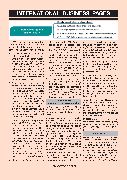INTERNATIONAL BUSINESS PAGES day 39%). Therefore the European tex- tile strategy must have a clear and strong global dimension, looking at both defensive and offensive elements. 1. We need to solve the market sur- veillance paradox by creating a net- work of market surveillance authori- ties (ADCO) including industry and NGOs and specialized in chemicals and sustainability in textile products to keep non- compliant products off the EU Single Market and develop methods for rapid decision making at customs to test critical imported products based on risk. 2. To ensure a level playing field across the global textiles industry, multilateral rules need to be estab- lished, as against “EU only” rules. This applies to environmental and social standards (due diligence), protection of property rights, etc. A stronger engagement with WTO, ILO and OECD is necessary in this re- gard. The implementation should be closely monitored and there should be predictable sanctions if the re- quirements are not met by the third country suppliers and partners. 3. From a regional perspective, EURATEX calls to resume dialogue with the US to agree on mutual rec- ognition of standards and certifica- tion procedures. EURATEX also calls for the rapid adoption of the FTA with Mercosur, which offers considerable market opportunities. We should also identify opportuni- ties for European textile companies in Africa, both in terms of sustain- able production and sales, and ne- gotiate FTAs with partners whose markets have a significant poten- tial for the European T&C industry. 4. The adoption of modernised rulesof origin under the PEM Conven- tion should offer a boost to supply chain development within the Pan Euro Mediterranean region. A dedi- cated campaign should be devel- oped to facilitate and support Eu- ropean textile companies in exploit- ing the potential of that “integrated” market. Fur thermore,the modernisation of the EU-Turkey Customs Union should be given an urgent start, to eliminate any pos- sible barriers to trade and ensure uninterrupted access to products. 5. To support the European textile SMEs in emerging markets, EURATEX suggests an economic diplomacy campaign, promoting European quality and design. This can be implemented in cooperation with international trade fairs and EU Delegations in third countries. Going forward: governance and implementation To successfully implement the above strategy, EURATEX calls on the Euro- pean Union to pay attention to the fol- lowing. When developing this strategy, policy coherence should be ensured. While the EU Green Deal provides an important basis, this textiles strategy needs to be aligned with other relevant EU poli- cies, including the EU Industrial strat- egy, the new EU Trade strategy, the EU Pact for Skills, the Sustainable Chemicals strategy, the Sustainable Product Initiative, etc. The strategy should lead to harmonised European actions and remove contradictions between EU policies. The textiles sector is a very “wide” in- dustry; it covers complex and global value chains involving multiple produc- tion steps, resulting in a variety of prod- NCM-OCTOBER 2021 58ucts, some of which are strategic to the European economy. To be mean- ingful, the strategy should consider the entire value chain of the industry, as it is closely interconnected, as well as it is directly linked to other sectors (agri- culture, chemicals, plastics, etc). Many of the technologies for making that transition already exist but invest- ments are needed to bring the circu- larity to industrial scale in the Euro- pean textile sector. Capital base within the industry is lim- ited and most companies are small or medium sized. It is important therefore to focus funding and investments to support and scale innovations, e.g., advanced bio-based and recycled ma- terials, technologies, green production technologies and advanced multifunc- tional products. To avoid frustration about lack of imple- mentation or follow up, the strategy should also suggest an appropriate governance set up; a (virtual) structure which gathers legitimate representa- tives of the industry, policy makers and other key stakeholders. EURATEX proposes to create a “tex- tile alliance” that will assess policy impact in textiles and avoid contradict- ing actions resulting from different policy areas. About EURATEX As the voice of the European textile and clothing industry, EURATEX works to achieve a favourable environment within the European Union for design, development, manufacture and mar- keting of textile and clothing products. The EU-27 textile and clothing indus- try, with around 160,000 companies employing 1.5 million workers, has an export turnover of over Euro 62 billion.
